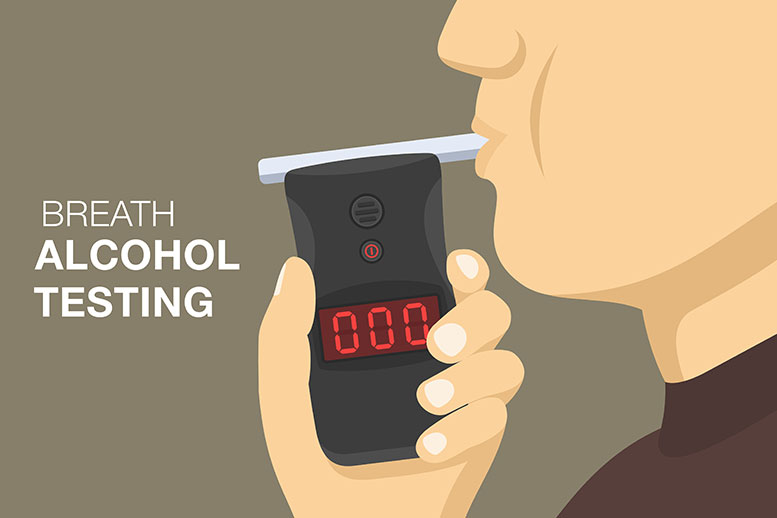Alcohol, often a staple in social environments, has repercussions that surpass the initial intoxication. Its trace in our breath, perceptible several hours post-drinking, bears significant ramifications for social, professional, and legal contexts. Understanding the duration of alcohol’s presence on breath and the complexities of breathalyzer test is crucial for informed and conscientious choices.
How Long Does Alcohol Stay on Your Breath?
The timeframe for alcohol’s detectability on breath typically spans 12 to 24 hours post-consumption. This duration hinges on several factors:
- Consumption Volume: Higher alcohol intake extends its detectability duration.
- Beverage Type: Variations in alcohol content across different beverages influence detectability length.
- Consumption Speed: Rapid drinking elevates and prolongs detectability levels.
- Physiological Composition: Body mass index (BMI) and fat percentage play roles in alcohol metabolism, impacting its persistence on breath.
- Metabolic Diversity: Individual metabolic rates dictate the speed of alcohol clearance from the body.
Understanding Breathalyzer Tests
Breathalyzers, tools for estimating blood alcohol concentration (BAC) through breath analysis, are influenced by:
- Recent Consumption: The interval between the last drink and the test significantly sways results.
- Beverage Alcohol Content: Higher alcohol content can lead to elevated BAC readings.
- Personal Attributes: Age, gender, and health status affect alcohol processing in the body and thus breathalyzer outcomes.
Factors Affecting Alcohol Metabolism
The liver primarily manages alcohol metabolism, with additional factors at play:
- Gender: Women may experience longer detectability due to differences in body composition and metabolic rates.
- Age: Slower metabolism with aging affects alcohol’s presence in the system.
- Body Size: Smaller individuals might experience prolonged alcohol presence.
- Health Conditions: Diseases impacting liver and kidneys can significantly alter metabolism rates.
Tips for Reducing Alcohol’s Impact on Breath
While no rapid method exists to eliminate alcohol from the system, certain steps can lessen its breath odor:
- Hydration: Water consumption aids in metabolizing and expelling alcohol.
- Oral Care: Brushing and mouthwash can conceal alcohol’s smell.
- Diet: Consuming fruits and vegetables may counteract bad breath from alcohol.
However, these techniques only disguise the smell and do not lower BAC.
Practical Advice and Consequences of Driving Under the Influence
For post-drinking driving, a general guideline is to wait a minimum of one hour per standard drink consumed. Individual reactions to alcohol vary; opting for an Uber or a designated driver is always safer.
Driving under the influence of alcohol is a serious crime. Facing misdemeanor or felony charges can dramatically impact someone’s life in case they survive an accident. In 2021 13,384 people died in alcohol-impaired driving traffic deaths.
The penalties for impaired driving includes license revocation, fines, and jail time. Check out Florida DUI laws to learn more.
In-Depth Look at Breathalyzers
Functionality and Reliability
Breathalyzers gauge breath alcohol levels through chemical or sensor-based reactions. While typically accurate, device calibration, user technique, and external factors like certain foods or health conditions can affect precision.
Operational Mechanism
Breathalyzers detect exhaled alcohol, translating chemical or electrical changes into BAC levels.
Limitations and Precision
Despite general reliability, issues like calibration, user error, and specific health conditions can impact accuracy. Mouth alcohol residue can also distort results.
Debunking Breathalyzer Myths: Can You Beat a Breathalyzer?
Tactics like sucking on pennies or consuming strong-smelling foods do not fool breathalyzers and pose legal risks. Limiting alcohol intake or allowing adequate metabolic time are the only reliable methods.
Alcohol in Our Society
Understanding the immediate and prolonged effects of alcohol, including its breath persistence, is vital for responsible use, especially in social and professional spheres.
Social and Health Considerations
Alcohol’s lingering scent can impact work and social interactions. Awareness and minimization strategies are key for maintaining decorum. Regular alcohol use poses significant health risks, including oral health issues that contribute to bad breath.
Breathalyzer Tests and Legal Implications
Driving under the influence is a grave legal matter. Knowledge of legal BAC limits and breathalyzer application in DUI cases is crucial for anyone who consumes alcohol and drives.
Comparing Legal Driving Limits For Different States
The standard BAC limits for drivers in all states is 0.08% for adults and 0.02% for drivers under the age of 21. Even below this threshold, driving impairment is possible.
| State | Legal BAC Limit |
|---|---|
| Florida (FL) | 0.08% |
| California (CA) | 0.08% |
| New York (NY) | 0.08% |
| Texas (TX) | 0.08% |
| Illinois (IL) | 0.08% |
Breathalyzers in DUI Cases
Law enforcement uses breathalyzers to ascertain legal limit breaches in drivers, with these readings often serving as DUI case evidence.
Frequently Asked Questions
What strategies can be used to comply with breathalyzer requirements?
To comply with breathalyzer requirements, there are several strategies you can employ:
- Waiting Period: If you have consumed alcohol, it is advisable to wait for a sufficient amount of time before taking the alcohol breath test. Allowing your body enough time to metabolize the alcohol will help reduce its concentration in your breath.
- Hydration: Drinking an adequate amount of water can help dilute the alcohol in your breath, although it won’t completely eliminate it. Over time, proper hydration may help lower the concentration of alcohol.
- Avoid Alcohol-Containing Products: It is best to avoid using mouthwash and breath sprays that contain alcohol before taking a breathalyzer test. These products can potentially give a high reading, even if you haven’t consumed alcohol.
- Follow Instructions: During your installation appointment, knowledgeable technicians will provide you with a step-by-step walkthrough on how to properly use the breathalyzer device. It may take a few attempts to become familiar with blowing into the device correctly. Blowing too hard or too softly can result in needing to retake the test.
By implementing these strategies, you can increase your chances of complying with breathalyzer requirements effectively.
How long does it take for alcohol to completely leave your system?
Alcohol clearance time varies, depending on factors such as the quantity of alcohol consumed and individual metabolic rates. Typically, the liver metabolizes one standard drink per hour.
Can food consumption affect breathalyzer results?
Consuming food can slow the absorption of alcohol into the bloodstream, potentially altering the timing of peak alcohol concentration in the blood and breath.
Are there any foolproof ways to beat a breathalyzer?
No guaranteed methods exist to trick a breathalyzer. The most responsible approach is moderate alcohol consumption and refraining from driving if alcohol has been consumed.
How does body weight affect alcohol metabolism?
Individuals with higher body weight generally have more body water, which can dilute the alcohol, potentially leading to a lower BAC compared to a lighter person drinking the same amount.
How long after drinking can you pass an interlock device test?
The wait time depends on the amount of alcohol consumed and individual metabolism. As a general rule, waiting at least one hour per standard drink is recommended before attempting to pass an interlock device test.
Does non-alcoholic beer affect breathalyzer results?
Non-alcoholic beer usually contains very small amounts of alcohol, unlikely to significantly impact breathalyzer results. Nevertheless, checking the specific alcohol content of the beverage is recommended.
Can a breathalyzer detect drugs other than alcohol?
Standard breathalyzers are designed to detect alcohol. There are specialized devices used by law enforcement that can detect certain drugs.
How long does it take for alcohol to wear off before driving?
It’s advisable to wait at least one hour for each standard drink consumed before driving. This can vary based on individual factors such as body weight and metabolism.
How long does beer stay in your system for a breathalyzer?
Beer, like other alcoholic beverages, typically remains detectable in your system and can be identified by a breathalyzer for up to 24 hours after consumption. The exact duration depends on the amount consumed and personal metabolic rate.
What should I do if I’m arrested after taking the breath test in Pal Beach County, Florida
After being arrested, the first thing you should do is hire a qualified Palm Beach County DUI attorney to defend your case.

 CALL US NOW
CALL US NOW







